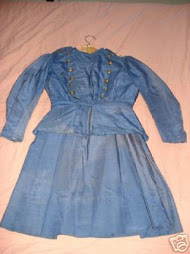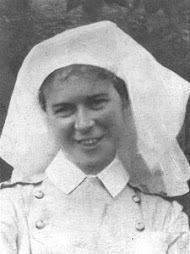Welcome back to Finding the Female Fallen. I’ve got loads of profiles, new information and resources, as well as a mystery or two to share over the next few weeks. My first story is about a remarkable nursing sister who served in both the British and Canadian nursing services before her death in the last month of the war. Her name was Ainslie St. Clair Dagg.
Ainslie was born in Selkirk, Manitoba on February 5, 1892. She was the daughter of James Dagg. Newspaper articles about Ainslie say that she was a student at Toronto’s Bishop Strachan School. However, according to archivist Susan Dutton, there are few records of her enrolment (formal attendance records weren’t kept until 1912). Susan suggests that Ainslie was probably one of a group of older girls who boarded at the school for a short period of time—a “finishing year.” She is listed as having won the drawing prize at the 1911 Closing Ceremony at BSS.
In 1916, Ainslie was a “pupil nurse” in Winnipeg in residence at the General Hospital. One of her classmates was Margaret Lowe, who would also become a casualty of the First World War. Ainslie would travel to England on the “Scandinavian” on October 12, 1916 begin her war service on the 21st of that month with the British nursing service—the Queen Alexandra's Imperial Military Nursing Service Reserve (QAIMNSR). At that time, she was posted to the 2nd Birmingham War Hospital and would serve there for 16 months.
The hospital to which Ainslie was assigned had an interesting history. At the beginning of the war, there were several military hospitals in Britain, but it soon became apparent that the needs demanded the establishment of many more. Country estates were often turned over to the military for this use, but by the middle of the war, more accommodation was needed. The Asylum War Hospital Scheme came in being in January 1915. Asylums across the UK were transformed into military hospitals, including the 2nd Birmingham War Hospital. Formerly the Hollymoor annex of the Birmingham City Asylum at Rubery Hill, the 2nd Birmingham Military Hospital was an extensive facility housing 930 patients. Opened in July 1915, it was an impressive complex of red brick with its own water tower and extensive kitchen facilities, located in close proximity to a rail line. By the time it closed in March 1920, it had treated 16,800 men. (For more information, read “The Long Long Trail: The British Army of 1914-18 for Family Historians” at http://www.1914-1918.net/southerngen.htm)
Ainslie must have made a good impression at the hospital. Her matron described her thus: “Her professional ability is the average standard. She is good-tempered and works well with her fellow nurses. She is a conscientious, steady worker and carries out all instructions given to her.” (Ainslie Dagg war records, National Archives). A photo of Ainslie taken during her wartime service reveals a lively, open-faced, full-of-fun, young woman.
After 16 months with the 2nd Birmingham War Hospital, Ainslie was transferred to the Royal Herbert Hospital in Woolwich. This hospital would gain a somewhat notorious reputation during the war. Writer Enid Bagnold served as a VAD at that facility and wrote a book about her experience (not an uncommon practice among VADs) called “Diary Without Dates. It was published in 1917 and was so critical of hospital administration that the military authorities arranged for her dismissal. Bagnold later went to France and worked as a volunteer driver and would go on to write “National Velvet.”
Bagnold certainly didn’t think much of the nurses (and sometimes the patients) at the hospital. “I shall never get to understand Sisters,” she wrote. “They are so strange, so tricky, uncertain as collies. Deep down they have an ineradicable axiom: that any visitor, any one in an old musquash coat, in a high-boned collar, in a spotted veil tied up at the sides, any one with whom one shakes hands or takes tea, is more important than the most charming patient (except, of course, a warded M.O.).” It is hard to imagine Ainslie as that kind of nurse, given her previous experience in Birmingham. Whatever the case, she only stayed at the Royal Herbert for six weeks before transferring to the CAMC in April 1918. Ainslie would spend the final months of her life at Number 15 Canadian General Hospital at the Cliveden Estate in Taplow.
Ainslie would not have long to enjoy her service at Taplow. On November 19, 1918, just a week after the Armistice, she fell dangerously ill with influenza. On the 29th of that month, she would die of bronchopneumonia. She would be buried on December 2nd in the Cliveden cemetery with full military honours. Her parents were visiting friends in Toronto when they received a cable telling them that their daughter had died. She was 26-years-old.
Thursday, August 30, 2012
Subscribe to:
Post Comments (Atom)






















I saw her gravestone today at Cliveden and decided to look up any information I could on her. What a lovely smile she had, so sad to die so young. A great project to remember these brave nurses who paid the ultimate price.
ReplyDelete